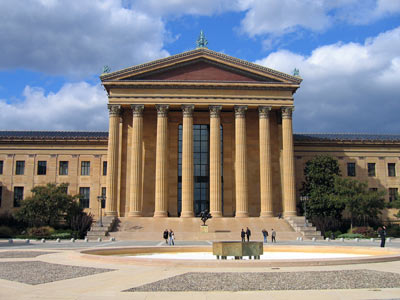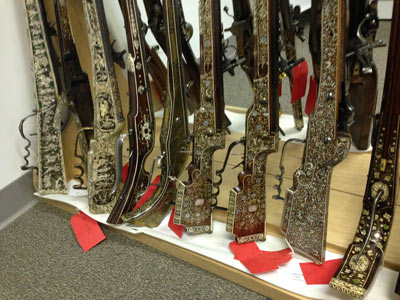Kretzschmar von Kienbusch donated the last great East Coast collection of pre-percussion arms and armor to the Philadelphia Museum of Art. A new baronial hall was built for horse & human armors, crossbows, thrusting pikes and edged weapons. Additionally, the collection includes princely match lock, wheel lock and flint lock pistols, rifles, and smooth bore muskets, many from Kienbusch’s native Germany. Fitting for a major art museum, arms were collected that brought together figurative and decorative artistry with technically demanding metallurgy and lock work. There are rare shooting accoutrements, such as powder flasks carved from deer antlers, petite priming powder flasks made of mother-of-pearl inlaid with silver, and a bandolier of seven wooden powder flasks dangling on cord from a velvet shoulder belt. A small but epicurean collection of sixteenth to eighteenth century pistols from England, Scotland, Italy, France and Spain include steel and silver stocked Scottish pistols, a pair of French Napoleonic Empire dueling pistols made by Boutet, a Spanish wheel lock pistol embellished with the finest silver filigree, and an Italian flintlock with a solid ivory stock. Hunting rifles are embellished with gold, ivory and silver, some with allegorical hunting scenes and others once belonging to Emperor Ferdinand III and Emperor Charles VI of Austria. After restoration, these arms will be put back on display. It is fitting that Kienbusch left his collection to Philadelphia in Pennsylvania, home to English and German gunsmiths of the 18th and 19th century, as well as the Frankford Arsenal ammunition plant. Whilst Philadelphia took a secondary role in the industrial production of firearms, it did provide the gunsmiths who built the prototype guns. The city was the host of the Centennial International Exhibition of 1876, and a selection of presentation firearms and ammunition was sent from the exhibition to the Smithsonian Institute, where is still remains.
http://www.philamuseum.org/collections/browse.html?sort=Artist&results=18&galleries=&galleryID=0&tr=0&lkID=0&pubID=&yf=0&packID=2085&tagID=&geoTerm=0&page=1&action=post


 1. West Point Museum
1. West Point Museum 2. Springfield Armory
2. Springfield Armory 3. Smithsonian Museum
3. Smithsonian Museum 4. Nunnemacher Milwaukee
4. Nunnemacher Milwaukee 5. Wadsworth Atheneum
5. Wadsworth Atheneum 6. Rock Island Arsenal
6. Rock Island Arsenal 7. Metropolitan Museum NY
7. Metropolitan Museum NY 8. National World War I
8. National World War I 9. FBI Reference Collection
9. FBI Reference Collection 10. NRA National Firearms
10. NRA National Firearms 11. Connecticut History
11. Connecticut History 12. Remington Firearms
12. Remington Firearms 13. Davis Arms Museum
13. Davis Arms Museum 14. National Cowboy Mus.
14. National Cowboy Mus. 15. American Precision
15. American Precision 16. Collectors Firearms
16. Collectors Firearms 17. KY Military History
17. KY Military History 18. Cody Firearms Museum
18. Cody Firearms Museum 19. Woolaroc Museum
19. Woolaroc Museum 20. Kienbusch Philadelphia
20. Kienbusch Philadelphia 21. John Browning Museum
21. John Browning Museum 22. Art Institute Chicago
22. Art Institute Chicago 23. Henry Stewart VMI
23. Henry Stewart VMI 24. Autry Museum
24. Autry Museum 25. Wood Museum S&W
25. Wood Museum S&W 26. National WWII Museum
26. National WWII Museum 27. Frazier History Museum
27. Frazier History Museum 28. Pennsylvania Longrifle
28. Pennsylvania Longrifle 29. Frank Brownell Museum
29. Frank Brownell Museum 30. Inst. Mil. Technology
30. Inst. Mil. Technology 31. NRA Bass Pro Sporting
31. NRA Bass Pro Sporting 32. U S Army Museum
32. U S Army Museum